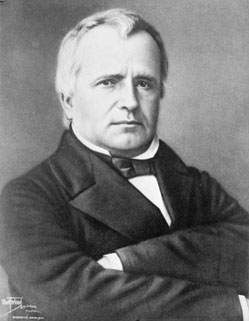| Louis Hippolyte LaFontaine  Born: 4-Oct-1807 Born: 4-Oct-1807
Birthplace: Boucherville, Quebec, Canada
Died: 26-Feb-1864
Location of death: Montreal, Quebec, Canada
Cause of death: unspecified
Gender: Male
Race or Ethnicity: White
Occupation: Head of State Nationality: Canada
Executive summary: Twice Co-Premier of Canada Canadian statesman and judge, third son of Antoine Ménard LaFontaine and Marie-J-Fontaine Bienvenue, was born at Boucherville in the province of Quebec on the 4th of October 1807. LaFontaine was educated at the Collège de Montréal under the direction of the Sulpicians, and was called to the bar of the province of Lower Canada on the 18th of August 1829. He married firstly Adèle, daughter of A. Berthelot of Quebec; and, secondly, Jane, daughter of Charles Morrison, of Berthier, by whom he had two sons. In 1830 he was elected a member of the House of Assembly for the county of Terrebonne, and became an ardent supporter of Louis Joseph Papineau in opposing the administration of the governor-in-chief, which led to the rebellion of 1837. LaFontaine, however, did not approve the violent methods of his leader, and after the hostilities at Saint Denis he presented a petition to Lord Gosford requesting him to summon the assembly and to adopt measures to stem the revolutionary course of events in Lower Canada. The rebellion broke out afresh in the autumn of 1838; the constitution of 1791 was suspended; LaFontaine was imprisoned for a brief period; and Papineau, who favored annexation by the United States, was in exile.
At this crisis in Lower Canada the French Canadians turned to LaFontaine as their leader, and under his direction maintained their opposition to the special council, composed of nominees of the crown. In 1839 Lord Sydenham, the governor-general, offered the solicitor generalship to LaFontaine, which he refused; and after the Union of 1841 LaFontaine was defeated in the county of Terrebonne through the governor's influence. During the next year he obtained a seat in the assembly of the province of Canada, and on the death of Sydenham he was called by Sir Charles Bagot to form an administration with Robert Baldwin. The ministry resigned in November 1843, as a protest against the actions of Lord Metcalfe, who had succeeded Bagot. In 1848 LaFontaine formed a new administration with Baldwin, and remained in office until 1851, when he retired from public life. It was during the ministry of LaFontaine-Baldwin that the Amnesty Bill was passed, which occasioned grave riots in Montreal, personal violence to Lord Elgin and the destruction of the parliament buildings. After the death of Sir James Stuart in 1853 LaFontaine was appointed chief justice of Lower Canada and president of the seigneurial court, which settled the vexed question of land tenure in Canada; and in 1854 he was created a baronet. He died at Montreal on the 26th of February 1864.
LaFontaine was well versed in constitutional history and French law; he reasoned closely and presented his conclusions with directness. He was upright in his conduct, sincerely attached to the traditions of his race, and labored conscientiously to establish responsible government in Canada. His principal works are: L'Analyse de l'ordonnance du conseil spécial sur les bureaux d'hypothèques (Montreal, 1842), and Observations sur les questions seigneuriales (Montreal, 1854). Father: Antoine Ménard LaFontaine (b. 1772, d. 1813)
Mother: Marie-J-Fontaine Bienvenue
Wife: Adèle Berthelot
Wife: Jane Morrison
University: Collège de Montréal
Do you know something we don't?
Submit a correction or make a comment about this profile
Copyright ©2019 Soylent Communications
|